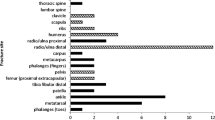Abstract:
The diagnostic use of BMD should be cautious as BMD is not an ideal measure of true bone density; it is not an ideal measure of bone strength; it does not predict fractures well; and it has inherent problems of accuracy and linearity. The limitations of BMD, based on the physical deficiencies of DXA, are further obscured by the introduction of T-scores.
It is suggested that BMD and BMC, when used diagnostically and for fracture risk classification, be used after correction for body size and/or bone size, age and sex, and that measured values be evaluated in the light of established mean fracture incidence data. BMD is not a parameter of sufficient validity to be the sole indicator of present and future fracture risk. A low BMD should be regarded one of several fracture risk factors.
It seems that there is a need to redefine the T-score based definition of osteoporosis.
Similar content being viewed by others
Author information
Authors and Affiliations
Additional information
Received: June 1999 / Accepted: September 1999
Rights and permissions
About this article
Cite this article
Pors Nielsen, S. The Fallacy of BMD: A Critical Review of the Diagnostic Use of Dual X-ray Absorptiometry. Clin Rheumatol 19, 174–183 (2000). https://doi.org/10.1007/s100670050151
Issue Date:
DOI: https://doi.org/10.1007/s100670050151




